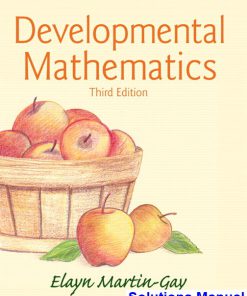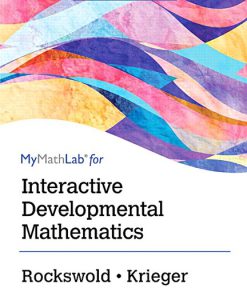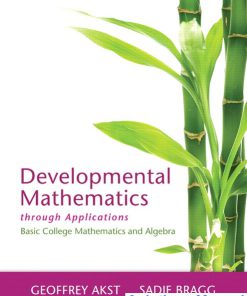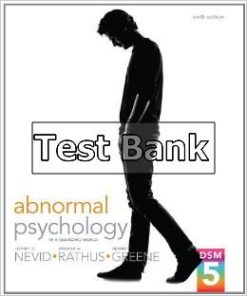Developmental Mathematics 1st Edition Blitzer Test Bank
You may also like
Developmental Mathematics 1st Edition Blitzer Test Bank
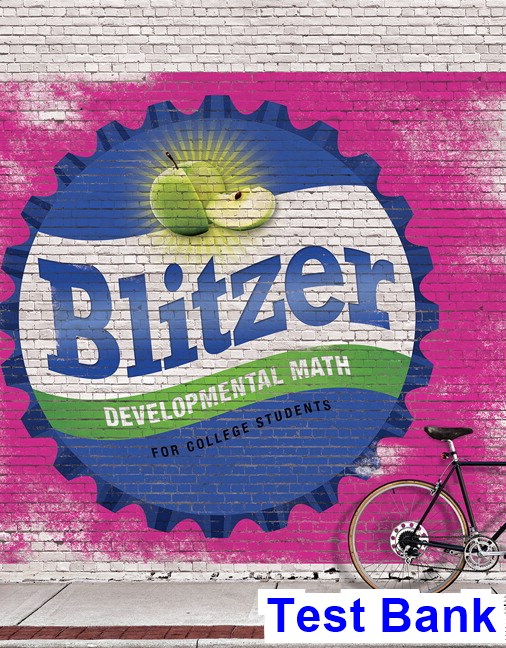
Product details:
- ISBN-10 : 0134269128
- ISBN-13 : 978-0134269122
- Author: Robert Blitzer
Bob Blitzer’s use of realistic applications instantly piques students’ curiosity about the presence of mathematical concepts in the world around them. These applications are apparent throughout the entire program-from his relatable examples, friendly writing style, and thought-provoking features in the textbook, to the enhanced digital resources in the MyMathLab course. Blitzer pulls from topics that are relevant to college students, often from pop culture and everyday life, to ensure that students will actually use their learning resources to achieve success. With an expansion of the series to now include a Developmental Math “all-in-one” text (with content spanning prealgebra through intermediate algebra), and with an enhanced media program accompanying this revision, developmental students at all levels will see how math applies to their daily lives and culture.
Developmental Mathematics 1st Edition Blitzer Solutions Manual
Table contents:
CHAPTER 1 Whole Numbers 1
1.1 Success in Mathematics 2
1.2 Fundamentals of Whole Numbers 8
1.3 Adding and Subtracting Whole Numbers 16
1.4 Multiplying Whole Numbers; Exponents 28
Putting the Concepts Together (Sections 1.2–1.4) 37
1.5 Dividing Whole Numbers 38
1.6 Prime Numbers 47
1.7 Order of Operations 54
Chapter 1 Review 59
Chapter 1 Test 65
Getting Ready for Chapter 2:
A Review of Whole Numbers 66
CHAPTER 2
CHAPTER 3
Integers and an Introduction to Algebra 68
2.1 Fundamentals of Integers 69
2.2 Adding and Subtracting Integers 74
2.3 Multiplying and Dividing Integers 83
2.4 Exponents; Order of Operations 89
Putting the Concepts Together (Sections 2.1–2.4) 95
2.5 Simplifying Algebraic Expressions 96
2.6 Linear Equations: The Addition and Multiplication Properties 107
2.7 Linear Equations: Using the Properties Together 116
2.8 Introduction to Problem Solving: Direct Translation Problems 124
Chapter 2 Review 136
Chapter 2 Test 142
Getting Ready for Chapter 3:
A Review of Chapters 1 and 2 143
Rational Numbers Expressed as Fractions 145
3.1 Fundamentals of Fractions 146
3.2 Multiplying and Dividing Fractions 162
3.3 Adding and Subtracting Like Fractions 174
Putting the Concepts Together (Sections 3.1–3.3) 183
3.4 Adding and Subtracting Unlike Fractions 184
3.5 Order of Operations and Complex Fractions 197
Sample Preface. Not for Distribution.
CHAPTER 4
CHAPTER 5
vi Contents
3.6 Operations with Mixed Numbers 204
3.7 Solving Equations That Contain Fractions 216
Chapter 3 Review 226
Chapter 3 Test 233
Getting Ready for Chapter 4:
A Review of Chapters 1–3 235
Rational Numbers as Decimals 239
4.1 Fundamentals of Decimals 240
4.2 Adding and Subtracting Decimals 250
4.3 Multiplying Decimals 260
4.4 Dividing Decimals 270
Putting the Concepts Together (Sections 4.1–4.4) 282
4.5 Solving Equations That Contain Decimals 283
Chapter 4 Review 290
Chapter 4 Test 294
Getting Ready for Chapter 5:
A Review of Chapters 1–4 295
Putting It Together: Real Numbers 299
Ratio, Proportion, and Percent 309
5.1 Ratios and Unit Rates 310
5.2 Proportions 318
5.3 Fundamentals of Percent Notation 330
Putting the Concepts Together (Sections 5.1–5.3) 337
5.4 Solving Percent Problems: Proportion Method 338
5.5 Solving Percent Problems: Equation Method 346
5.6 Applications Involving Percent 355
Chapter 5 Review 367
Chapter 5 Test 373
Getting Ready for Chapter 6:
A Review of Chapters 1–5 375
CHAPTER 6 Measurement and Geometry 378
6.1 The U.S. Standard (English) System of Measurement 379
6.2 The Metric System of Measurement 393
Putting the Concepts Together (Sections 6.1–6.2) 402
6.3 Fundamentals of Geometry 403
6.4 Introduction to Square Roots and the Pythagorean Theorem 413
Sample Preface. Not for Distribution.
Contents vii
6.5 Polygons 421
6.6 Perimeter and Area of Polygons and Circles 433
6.7 Volume and Surface Area 448
Chapter 6 Review 455
Chapter 6 Test 462
Getting Ready for Chapter 7:
A Review of Chapters 1–6 464
CHAPTER 7 Introduction to Statistics and the Rectangular Coordinate
System 468
7.1 Tables and Graphs 469
7.2 Mean, Median, and Mode 485
Putting the Concepts Together (Sections 7.1 and 7.2) 495
7.3 The Rectangular Coordinate System and Equations in Two Variables 497
7.4 Graphing Equations in Two Variables 510
Chapter 7 Review 520
Chapter 7 Test 525
Getting Ready for Elementary Algebra:
A Review of Chapters 1–7 527
CHAPTER 8 Equations and Inequalities in One Variable 531
8.1 Linear Equations: The Addition and Multiplication Properties of Equality 532
8.2 Linear Equations: Using the Properties Together 541
8.3 Solving Linear Equations Involving Fractions and Decimals; Classifying
Equations 548
8.4 Evaluating Formulas and Solving Formulas for a Variable 558
Putting the Concepts Together (Sections 8.1–8.4) 569
8.5 Problem Solving: Direct Translation 570
8.6 Problem Solving: Problems Involving Percent 582
8.7 Problem Solving: Geometry and Uniform Motion 588
8.8 Solving Linear Inequalities in One Variable 598
Chapter 8 Activity: Pass to the Right 610
Chapter 8 Review 610
Chapter 8 Test 616
CHAPTER 9 Introduction to Graphing and Equations of Lines 618
9.1 The Rectangular Coordinate System and Equations in Two Variables 619
9.2 Graphing Equations in Two Variables 632
9.3 Slope 645
Sample Preface. Not for Distribution.
viii Contents
9.4 Slope-Intercept Form of a Line 655
9.5 Point-Slope Form of a Line 664
9.6 Parallel and Perpendicular Lines 672
Putting the Concepts Together (Sections 9.1–9.6) 680
9.7 Linear Inequalities in Two Variables 681
Chapter 9 Activity: Graphing Practice 689
Chapter 9 Review 690
Chapter 9 Test 696
Cumulative Review Chapters 1–9 697
CHAPTER 10
CHAPTER 11
CHAPTER 12
Systems of Linear Equations and Inequalities in Two Variables 698
Exponents and Polynomials 758
Factoring Polynomials 818
10.1 Solving Systems of Linear Equations by Graphing 699
10.2 Solving Systems of Linear Equations Using Substitution 710
10.3 Solving Systems of Linear Equations Using Elimination 718
Putting the Concepts Together (Sections 10.1–10.3) 727
10.4 Solving Direct Translation, Geometry, and Uniform Motion Problems Using
Systems of Linear Equations 727
10.5 Solving Mixture Problems Using Systems of Linear Equations 734
10.6 Systems of Linear Inequalities 744
Chapter 10 Activity: Find the Numbers 751
Chapter 10 Review 751
Chapter 10 Test 757
11.1 Adding and Subtracting Polynomials 759
11.2 Multiplying Monomials: The Product and Power Rules 768
11.3 Multiplying Polynomials 773
11.4 Dividing Monomials: The Quotient Rule and Integer Exponents 784
Putting the Concepts Together (Sections 11.1–11.4) 796
11.5 Dividing Polynomials 797
11.6 Applying Exponent Rules: Scientific Notation 804
Chapter 11 Activity: What Is the Question? 810
Chapter 11 Review 811
Chapter 11 Test 816
Cumulative Review Chapters 1–11 817
12.1 Greatest Common Factor and Factoring by Grouping 819
12.2 Factoring Trinomials of the Form x2 + bx + c 828
12.3 Factoring Trinomials of the Form ax2 + bx + c, a ≠ 1 836
Sample Preface. Not for Distribution.
Contents ix
CHAPTER 13 Rational Expressions and Equations 882
13.1 Simplifying Rational Expressions 883
13.2 Multiplying and Dividing Rational Expressions 891
13.3 Adding and Subtracting Rational Expressions with a Common
Denominator 899
13.4 Finding the Least Common Denominator and Forming Equivalent
Rational Expressions 906
13.5 Adding and Subtracting Rational Expressions with Unlike
Denominators 913
13.6 Complex Rational Expressions 923
Putting the Concepts Together (Sections 13.1–13.6) 930
13.7 Rational Equations 931
13.8 Models Involving Rational Equations 943
Chapter 13 Activity: Correct the Quiz 956
Chapter 13 Review 957
Chapter 13 Test 962
Cumulative Review Chapters 1–13 963
Getting Ready for Intermediate Algebra:
A Review of Chapters 1–13 965
Getting Ready for Intermediate Algebra:
Interval Notation 967
12.4 Factoring Special Products 846
12.5 Summary of Factoring Techniques 853
Putting the Concepts Together (Sections 12.1–12.5) 859
12.6 Solving Polynomial Equations by Factoring 859
12.7 Modeling and Solving Problems with Quadratic Equations 868
Chapter 12 Activity: Which One Does Not Belong? 875
Chapter 12 Review 875
Chapter 12 Test 879
Getting Ready for Intermediate Algebra:
A Review of Chapters 1–12 880
CHAPTER 14 Graphs, Relations, and Functions 971
14.1 Graphs of Equations 972
14.2 Relations 982
14.3 An Introduction to Functions 988
14.4 Functions and Their Graphs 999
Putting the Concepts Together (Sections 14.1–14.4) 1009
14.5 Linear Functions and Models 1010
14.6 Compound Inequalities 1024
Sample Preface. Not for Distribution.
CHAPTER 15 Radicals and Rational Exponents 1065
15.1 Square Roots 1066
15.2 nth Roots and Rational Exponents 1070
15.3 Simplifying Expressions Using the Laws of Exponents 1078
15.4 Simplifying Radical Expressions Using Properties of Radicals 1084
15.5 Adding, Subtracting, and Multiplying Radical Expressions 1093
15.6 Rationalizing Radical Expressions 1099
Putting the Concepts Together (Sections 15.1–15.6) 1105
15.7 Functions Involving Radicals 1105
15.8 Radical Equations and Their Applications 1112
15.9 The Complex Number System 1120
Chapter 15 Activity: Which One Does Not Belong? 1131
Chapter 15 Review 1131
Chapter 15 Test 1138
Cumulative Review Chapters 1–15 1138
CHAPTER 16 Quadratic Equations and Functions 1140
16.1 Solving Quadratic Equations by Completing the Square 1141
16.2 Solving Quadratic Equations by the Quadratic Formula 1153
16.3 Solving Equations Quadratic in Form 1167
Putting the Concepts Together (Sections 16.1–16.3) 1174
16.4 Graphing Quadratic Functions Using Transformations 1175
16.5 Graphing Quadratic Functions Using Properties 1187
16.6 Polynomial Inequalities 1201
16.7 Rational Inequalities 1212
Chapter 16 Activity: Presidential Decision Making 1218
Chapter 16 Review 1218
Chapter 16 Test 1225
CHAPTER 17 Exponential and Logarithmic Functions 1227
17.1 Composite Functions and Inverse Functions 1228
17.2 Exponential Functions 1241
17.3 Logarithmic Functions 1257
Putting the Concepts Together (Sections 17.1–17.3) 1269
x Contents
14.7 Absolute Value Equations and Inequalities 1034
14.8 Variation 1045
Chapter 14 Activity: Shifting Discovery 1052
Chapter 14 Review 1053
Chapter 14 Test 1062
Sample Preface. Not for Distribution.
CHAPTER 18 Conics 1294
18.1 Distance and Midpoint Formulas 1295
18.2 Circles 1301
18.3 Parabolas 1307
18.4 Ellipses 1317
18.5 Hyperbolas 1326
Putting the Concepts Together (Sections 18.1–18.5) 1333
18.6 Systems of Nonlinear Equations 1333
Chapter 18 Activity: How Do You Know That . . . ? 1340
Chapter 18 Review 1340
Chapter 18 Test 1344
CHAPTER 19 Sequences, Series, and the Binomial Theorem 1346
19.1 Sequences 1347
19.2 Arithmetic Sequences 1354
19.3 Geometric Sequences and Series 1361
Putting the Concepts Together (Sections 19.1–19.3) 1373
19.4 The Binomial Theorem 1373
Chapter 19 Activity: Discover the Relation 1379
Chapter 19 Review 1379
Chapter 19 Test 1383
Cumulative Review Chapters 1–19 1384
People also search:
Developmental Mathematics 1st Edition Blitzer
developmental mathematics 4th edition pdf
blitzer introductory and intermediate algebra
blitzer thinking mathematically 8th edition
developmental mathematics basic mathematics and algebra




